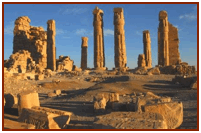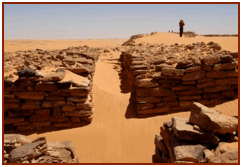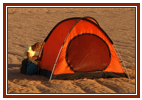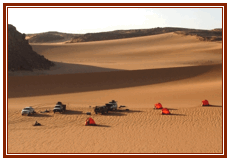Sudan/ENtdeckungsreise
- Landesinfo
- Das antike Zauberland (15 Tage)
- Die nubischen Wüsten (9 Tage)
- Das Königreich der Schwarzen Pharaos (9 Tage) + 3 Nächte auf Option
- Nubien und die westliche Wüste (16 Tage)
- Jebel Uweinat sudan (16 Tage)
- SUDAN – Berenike - Nomads and desert from Nubia(16 Tage)
Jebel Uweinat - Sudan (16 Tage)
A long and tough expedition through the Western Desert to reach the Jebel Uweinat, the mysterious mountains on the border with Egypt and Libya. Travelling through more than 2000 kilometers off road, in an area wide like half Europe, where we will discover all the beauties of Sahara Desert. Interesting encounters with the nomads and some of the less visited archaeological sites. After a first visit of the fortress of Gala Abu Ahmed, we will discover the Temple of Soleb and reach the oasis of Selima. After this suggestive archaeological sites, still untouched by tourists we will reach the majestic Jebel Unweinat, a great mountain of 2000m high situated on the border among Sudan, Egypt and Libia. Among its valleys we will discover the most rich and beautiful “rock art museum” of the whole Sahara.
An expedition through breathtaking landscapes and welcoming local population. Overnights in wild camp under the starry African sky.
Day 1 / Khartoum 20.02.2015
Arrive in Khartoum. Meet and greet with the guide. Transfer to the hotel.
Day 2 / Khartoum – Tam Tam – Desert - 21.02.2015
Breakfast at the hotel and then short tour of Khartoum. We follow the Blue Nile near the Presidential Palace where in 1885 General Gordon was beheaded by the Mahdist troops. Visit at the interesting Archaeological Museum that, besides many beautiful objects, from the prehistoric time to the Meroitic and Egyptien period and hosts three whole temples (Semna East, Semna West, Buhen) rescued by the UNESCO and moved from the Lake Nasser area, when it was flooded by the water. (The visit can be moved to the last day according to closing time). In particular we find ancient ceramics, granite statues, sarcophagi, bas-reliefs and Jewells discovered by the numerous archaeological expeditions. At the first floor there is an astonishing collection of Christian frescoes which come from the Faras Cathedral in the north. We then cross the confluence between the Blue and the White Nile and we reach Omdurman, the old capital of Sudan, where we see the Mahdi’s tomb from outside and the Khalifa’s House Museum. This local hero was able to gather all different tribes in the name of a strong religious fanaticism to fight against the army anglo-egyptien. The expedition departs late morning (after getting the travel permits) heading north. Lunch on the way in a local restaurant. We then reach Tam Tam, a simple but curious little village settle in the desert since the building of the tarmac road. We look for a nice place where to camp. Dinner and overnight in tents. (B.L.D.)
Day 3 / Dongola – the temple of Soleb – 22.02.2015
 We continue northward till we reach the tar road that leads to the Nile and to the town of Dongola where we fill up all our tanks with fuel and water. We reach the Nile; we are in the central part of the Nubian region. The population speaks a different language from the Arabs, and the Islamic religion is not as "strict" as in other regions. The women don't cover their faces and readily speak to foreigners. The villages are particularly beautiful thanks to the coloured front doors of the houses which seem to welcome the guest. We reach the Temple of Soleb, the most beautiful Egyptian temple of all Sudan, testimony of the New Kingdom in Nubia, with many walls rich in hieroglyphic inscriptions, bas-relief figures and many columns. The first settlement dates from 1500 B.C at the time of the first Egyptian colonisation. Overnight in a typical private Nubian house. A visit at the temple at night time is expected. (B.L.D)
We continue northward till we reach the tar road that leads to the Nile and to the town of Dongola where we fill up all our tanks with fuel and water. We reach the Nile; we are in the central part of the Nubian region. The population speaks a different language from the Arabs, and the Islamic religion is not as "strict" as in other regions. The women don't cover their faces and readily speak to foreigners. The villages are particularly beautiful thanks to the coloured front doors of the houses which seem to welcome the guest. We reach the Temple of Soleb, the most beautiful Egyptian temple of all Sudan, testimony of the New Kingdom in Nubia, with many walls rich in hieroglyphic inscriptions, bas-relief figures and many columns. The first settlement dates from 1500 B.C at the time of the first Egyptian colonisation. Overnight in a typical private Nubian house. A visit at the temple at night time is expected. (B.L.D)
Day 4 - 5 - 6 / Western Desert – Selima Oasis – Jebel Uweinat – 23-25.02.2015
Few kilometers away from the Temple of Soleb, we visit the Jebel Dosha where a chapel is excavated in the rock probably wanted by Thutmosi III. The walls are rich on images of the Pharaoh giving offering to the Gods. The landscape is astonishing: we will climb the hill to get a spectacular view of the river. We leave the green belt of the Nile and we enter the Western Desert also called the Libyan Desert. It is one of the less explored area of the Sahara, it is a very large area (about twice the surface of Italy) that arrives to the border with Egypt in the north and to Chad in the West. It is a real desert where very little form of life survives: no trees nor bush and no human settlements nor permanent roads. Crossing some stony hills we reach Selima Oasis, located in a depression of the desert where there are few palm trees and bush. In the past, this oasis, now not inhabited with the exception of a small police checkpoint, was very important because of the well mainly used by the desert caravans. Not far we can see a still mysterious stone building which is covered with enigmatic engravings; it was probably build by the Turk few centuries ago as a check point for the caravans directed to Egypt. We leave the place and two more days are necessary to be able to see the silhouette of Jebel Uweinat. Overnights in the desert. (B.L.D)
Day 7 - 8 / Jebel Uweinat – Jebel Kissu – 26-27.02.2015
 We spend one and half days exploring the wadis of this mountain. Jebel Uweinat (about 2.000 m. high) is the most incredible mountain in the Libyan Desert. Situated roughly in the centre of one of the driest area in the Sahara, exactly at the border among Sudan, Libya and Egypt, it is like an island above the surrounding plain. Its height is sufficient to capture the very little rain that occasionally reaches this area. These rains are very rare and they might occur every 10-15 years, however even this little water is enough to allow some vegetation and wildlife to survive in those valleys. Jebel Uweinat was first discovered by the Egyptian explorer Ahmed Hassanein during his first Western Sahara crossing in 1923, but the real exploration was done by the Hungarian explorer László Almásy in the ‘30ies. Geologically speaking the mountain is made by a shield of granite rocks covered by sedimentary sandstone rocks, eroded by the wind into unusual shapes. The sandstone slab forms an elevated plateau that is dissected into several large units. The most important valley,Karkur Talh is in the in Sudan part of the Jebel. In prehistoric times, the mountain was densely populated, as attested by the hundreds of rock paintings and engravings that may be found in shelters along the sides of all the main valleys perfectly preserved by the dry climate. Probably the most rich and beautiful “rock art museum” of the whole Sahara. We will spend time exploring the Sudanese part of this mountain. The afternoon of the day 8 we will travel southward to reach the Jebel Kissu. Overnights in the desert. (B.L.D)
We spend one and half days exploring the wadis of this mountain. Jebel Uweinat (about 2.000 m. high) is the most incredible mountain in the Libyan Desert. Situated roughly in the centre of one of the driest area in the Sahara, exactly at the border among Sudan, Libya and Egypt, it is like an island above the surrounding plain. Its height is sufficient to capture the very little rain that occasionally reaches this area. These rains are very rare and they might occur every 10-15 years, however even this little water is enough to allow some vegetation and wildlife to survive in those valleys. Jebel Uweinat was first discovered by the Egyptian explorer Ahmed Hassanein during his first Western Sahara crossing in 1923, but the real exploration was done by the Hungarian explorer László Almásy in the ‘30ies. Geologically speaking the mountain is made by a shield of granite rocks covered by sedimentary sandstone rocks, eroded by the wind into unusual shapes. The sandstone slab forms an elevated plateau that is dissected into several large units. The most important valley,Karkur Talh is in the in Sudan part of the Jebel. In prehistoric times, the mountain was densely populated, as attested by the hundreds of rock paintings and engravings that may be found in shelters along the sides of all the main valleys perfectly preserved by the dry climate. Probably the most rich and beautiful “rock art museum” of the whole Sahara. We will spend time exploring the Sudanese part of this mountain. The afternoon of the day 8 we will travel southward to reach the Jebel Kissu. Overnights in the desert. (B.L.D)
Day 9 - 10 - 11 - 12 / Crossing the Western Desert - 28.02.2015 till and 03.03.2015
Jebel Kissu, is a solitary massive granite outcrop, where the eroded rock boulders pile up almost continuously around the foot of the mountain. In some part the boulders form shelters. The first British explorers who travelled in the area recorded in their diaries to have found some rock paintings. We will look for them as there are no clear information about where they actually are. We drive now southeast and we cross the old caravan route Darb El Arbain “the forty days road” one of the oldest caravan route across the Sahara desert. It connects the Nile valley in Egypt to the savannah lands of central Sudan. Here we can find hundreds of camel skeletons on the route. We will meet sand dunes and other rock formations until we reach Laqiya Umran, a small desert oasis with few palm trees but without any water well (actually there is a small military check point). Driving always southeast we reach a depression characterized by white flat salt formations, isolated palm trees and small villages inhabited by few dozen of people. We then travel towards the Nile until we reach Dongola, where we will refill with water, food and petrol. Overnights in the desert. (B.L.D)
Day 13 - 14 / Dongola - Western Desert – Wadi el Milk - 04-05.03.2015
 After having refilled in Dongola, we go back to the desert passing by small oasis reach on palm trees. Then south-east again to reach a curious mountain in the middle of dune desert called by our drivers Jebel Peak. Still heading south we reach a mysterious fortress in the middle of the desert: Gala Abu Hamed, discovered by a German archaeological expedition and dated to the Napatean time (700-400 B.C.). The ruins of the fortress are mainly huge boundary walls of about 100 m, now partially covered by sand. The place was probably used has a prison for slaves coming from Central Africa. It remains a mystery how the place could have been inhabited since there is no water at all. Keep driving south, we reach Wadi El Milk, here we will find many acacia trees and Bisharin settlements around the few water wells. Last overnight in wild camp. (B.L.D.)
After having refilled in Dongola, we go back to the desert passing by small oasis reach on palm trees. Then south-east again to reach a curious mountain in the middle of dune desert called by our drivers Jebel Peak. Still heading south we reach a mysterious fortress in the middle of the desert: Gala Abu Hamed, discovered by a German archaeological expedition and dated to the Napatean time (700-400 B.C.). The ruins of the fortress are mainly huge boundary walls of about 100 m, now partially covered by sand. The place was probably used has a prison for slaves coming from Central Africa. It remains a mystery how the place could have been inhabited since there is no water at all. Keep driving south, we reach Wadi El Milk, here we will find many acacia trees and Bisharin settlements around the few water wells. Last overnight in wild camp. (B.L.D.)
Day 15 / Western Desert - Khartoum 06.03.2015
Continuing southward the vegetation will increase: we are almost in the Sahel. We will drive in the desert to reach the road that leads to Omdurmann, the old capital of Sudan and now the largest souk,where there is the possibility to buy some local handcrafts. At sunset time we move near the tomb of the sufi leader Ahmed al Nil to assist at the involving Whirling Dervishes Ceremony (only on Fridays). Arrival in Khartoum, crossing the White Nile on the old British bridge. Check in at the hotel where the rooms are available in day use till 23.00. Dinner not included. (B.L.)
Day 16 / Departure 07.03.2015
Transfer and boarding the international flight to Europe.
Technical information:
A crossing of more than 2000 kilometres of wild and unknown desert cannot be perfectly planned. During the tour we might make some small changes to the itinerary. The tour guide has the responsibility of the tour and he will take all the necessary decisions to guarantee the safety of the passengers. We ask the passengers (real pioneers) to be flexible and “open minded”. The tour is organised with 4x4 cars fully equipped for desert expeditions with GPS navigation instruments and satellite telephone (4 pax for each car). A support car to carry fuel and water will follow the passenger’s cars.


THE WILD CAMP
For the overnights in wild camp in the desert we supply the following equipment:
- Igloo tents, 2 x 2 m., supplied by the manufacturer for three person but used by two or in single (very easy to set up, 3-4 minutes)
- Foam mattresses 5 cm. thick 2 x 0, 60 m.
- Folding chairs with arms and folding tables
- Gas lights, thermos for water, plates and all the cutlery
- A water basin for personal washings
- A first aid kit
A cook will be in charge of the meals
The quotation includes:
- meeting at airport and private transfer to hotel
- 1 O/N at Holiday Villa hotel (4****) in Khartoum in BB
- 1 day use at Holiday Villa till 11.00pm
- all the camping equipment for the overnights in camp (igloo tent,
rubber foam mattress) and a cook in charge of the meals
- transport with Toyota Land Cruisers 4x4 or Toyota Hilux (3 pax per car guaranteed) – extra car for carrying fuel and extra water
- mineral water outside Khartoum
- TL English speaking
- Sudanese staff
- National Museum and archaeological sites entry fees
- photo permit
- passport registration
The quotation does not include:
- The meals and drinks in Khartoum - soft drinks - sleeping bag and pillow while camping - video camera permits at the archaeological sites (at the moment 20 USD per site per video camera) - personal expenses - Sudan entry Visa and visa authorization - tips
Termine im Jahr 2015:
| Termine | Preis | EZ | |
|---|---|---|---|
| 1 | 20.02. - 07.03. | 2116 | 81 |
Gruppe von 10 - 12 Personen
EZ= Einzelzimmerzuschlag
Messerabatt 6%
Interkulturelle Vorbereitung von Auslandsaufenthalten:
Fotos & Videos
Reiseberichte:
Kontakte:
Vor der Reise:
Presse:
